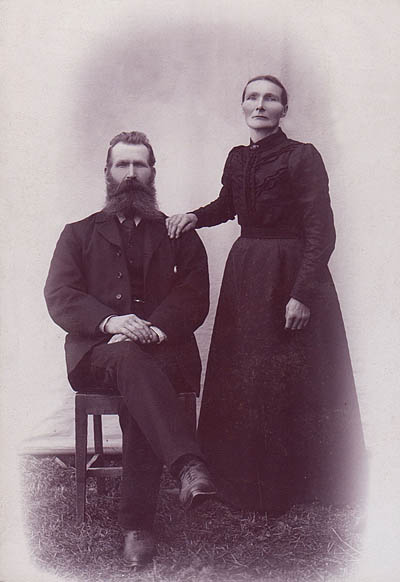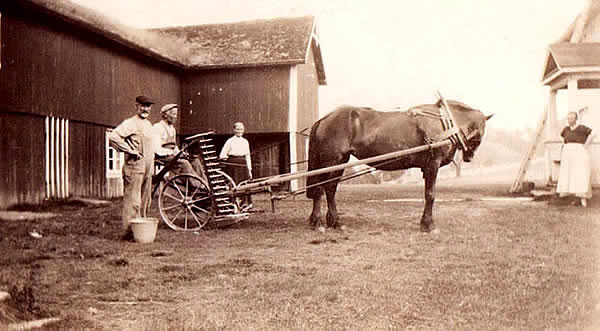
Ole Franzen Kjelstrup vokste opp på gården Rønningen i Meråker, som han overtok av sin far da han var 15 år.
Han tok da navnet Rønning.
Ole hadde også annet arbeid ved siden av å drive gården. Bl.a. arbeidet han ved kopperverket. Da det i 1886 ble
tresliperi ved Nustadfoss, ble Ole formann der. Det ble bygd lagerhus ved Meraker stasjon, og der var det
reservelager for massen fra tresliperiet. Der skulle Ole holde regning med tilgang og avgang av tremasse (som ble
fraktet med jernbane til Hommelvik og videre med båt, for det meste til England).
Ole var også kirketjener i bygda.
Rønningen gård i Meraker ca. 1930.

Ole Frantzen Kjelstrup Rønning (1853 – 1932)
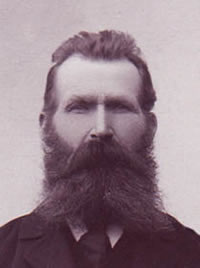
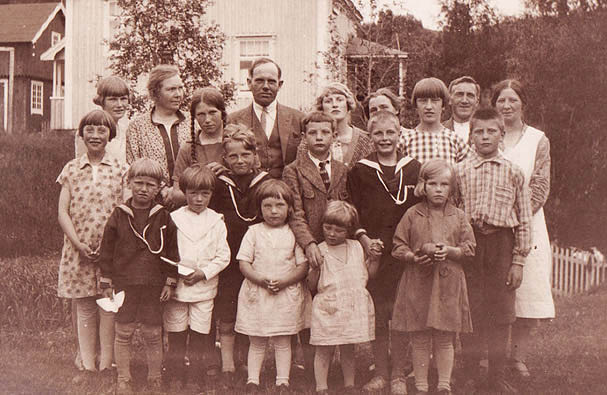
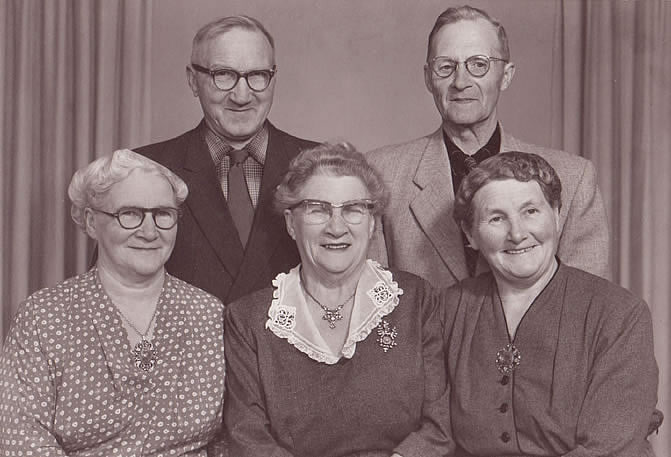
Noen Etterkommere: Bakerst: Anna Rønning, Astrid Rønning, Hjalmar Svendsen, Bergljot (Lotte) Wold, Olga Svendsen, Hjørdis Wold (Merakernes), Per Rønning, Clara Rønning. I midten: Else Wold (Merakernes), Hedvig Svendsen, Osvald Svendsen, Asbjørn (Claras nevø), Odd Rønning, Thoralf (Merakernes). Foran: Tor Rønning, Ivar (Merakernes), Solveig Svendsen, Ukjent pike og Hjørdis Svendsen.
Noen av barna
i voksen alder: Peder (Per), Erik, Olga, Marit («Mary») og Elisabeth.
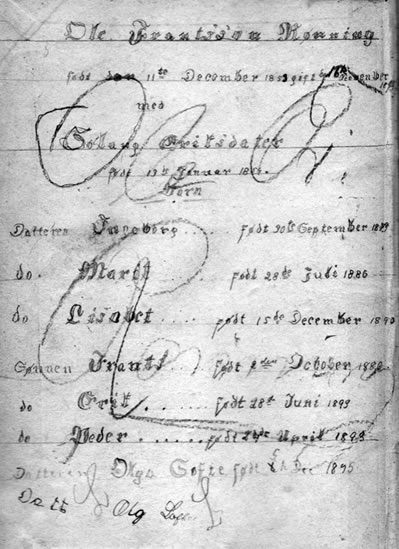
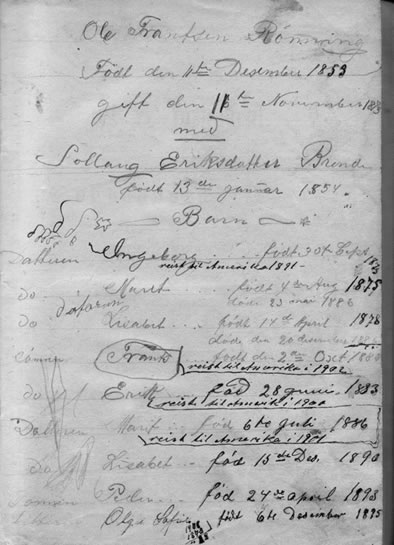
Bildene viser de første sidene i «Søndagsprædikener».
Dette var en bok som må ha ligget hjemme hos Ole og Solaug, og som de noterte begivenheter i.
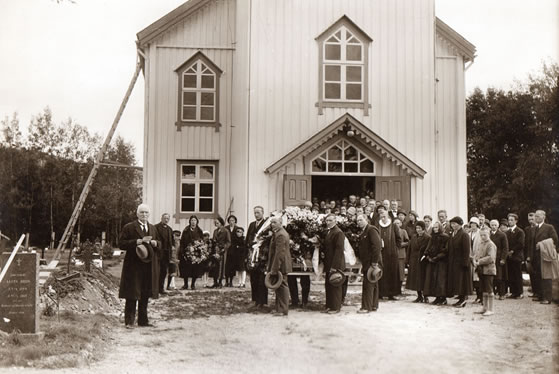
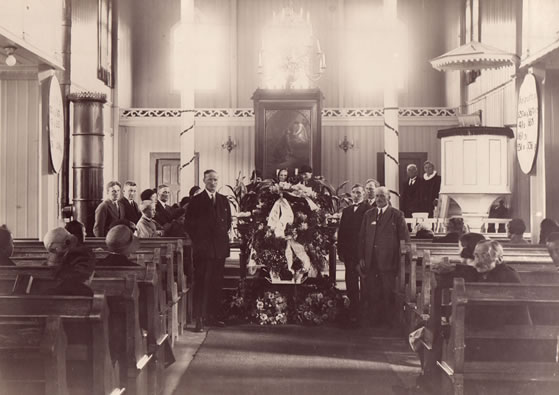
Begravelse for Ole. Meråker kirke.
Gravstøtten ved Meråker kirke
RØNNINGEN IN MERAKER - THE PEOPLE THAT LIVED THERE (From Hedvig Johansen’s booklet about Rønningen)
We reckon our grandfathers grandfather on his father’s side, PEDER ENGE KJELSTRUP 1764 – 1857
was the first of our ancestors to settle at Rønningen. We also suppose that the "old house", still being here, was built in his time, in 1830 – 1840.
Grandfathers parents were:
FRANTZ PEDERSEN KJELSTRUP 1804 - 1868
INGEBORG OLSDATTER TØMMERMO 1812 - 1880
9 children were born, two died when infants, and of the other 7, only the two youngest were at home when Frantz died in 1868.
We know some of them immigrated to USA, like many other in those days. But only three of those who left, sent words back: Frantz, John and Beret in USA. Peder Enge and Peder Bredal are supposed to have left for places with more opportunities in Norway, or maybe they went to sea.
Like his ancestors, Frantz worked at the mining company, farming in his spare time.
From old documents we find that in 1865 1/8 "tønne" of oats and 1 "tønne" potatoes were planted, the animals were 5 cows, 7 cheeps and 10 goats.
The outfarm was at Øst-fjerdingen, which explains why a small farm could have that many animals.
The grass on the grounds was used effectively, and cheese and butter produced in summer was a good help in wintertime. The tools were quite primitive in those days, and they must have worked long hours to manage it all, outdoors and indoors.
Of grandfather’s sisters and brothers we only knew his youngest sister Lisbet, born July 28th 1856.
She mostly stayed at Rønningen, but was also away to work elsewhere. Growing old, she moved to a pensioner’s home, near Stormyra.
She also lived long enough to move to the new pensioners home, which was closer to her birthplace, and where we could visit her more often. Aunt Lisbet was a very nice person, and we enjoyed visiting her. She died March 3rd, 1940.
Grandfather’s brother, John, born 1841, left early for USA. For some years we received letters and pictures, but with his brother Frantz (b. 1851) and his sister Beret (b. 1848) the contact lasted longer, they were also younger.
We know that Frantz died in 1926, and that his granddaughter Peg, Lynch, married grandfathers grandchild, Odd Rønning. Our mother, Olga Sofie, had something to do with that, as she sent addresses for some relatives with Odd, when he went to USA for studies. Quite a happy result!
The brothers Peder Enge (b. 1836), Ola (b.1838) and Peder Bredal (b. 1845) do we not know much about. We know that Peder Enge married the two year younger Lisbet Ingvaldsdatter, but not where they went and not if they later changed their name to Rønning, like grandfather did.
We suppose Ola died young. Our grandfather was named after him. We know nothing about Peder Bredal, except that mother thought he maybe went to the northern part of Norway, to try his luck fishing.
So, we have to concentrate on grandfather and his descendants.
Our grandfather OLE FRANTZEN KJELSTRUP 1853 - 1932
was only 15 years old when he took over the farm. His father died in 1868 and his mother being then over 50, could not cope with the work alone. Both Ole and Lisbeth had to help out to keep things going.
Father found his bride at the farm Over Brænde, SOLAUG ERIKS DATTER OVERBRÆNDE 1854 - 1936
We do not have all the facts to make sure the story will be complete, but we will try to include what we remember and have heard about people we know, and about the people we never met., even if they grew up here.
From the family register on previous pages, made by Knut Skarning (married to my cousin Anna) for uncle Erik’s 90th birthday, you can see that grandmother’s family comes from the farms Tømmerås, Fundaunet, Nustad and Stubban.
Grandmothers parents were:
ERIK JOHNSEN OVERBRÆNDE 1812 -1907
and MARIT HALVORS DATTER STUBBAN 1817 - 1875
They got 12 children, two died young and two of the others were named after them. The 10 children lived to be quite old, and they have many descendants.
Our grandmother was often visited by her brothers and sisters, two of her sisters stayed i Meråker all their life. Two brothers also stayed in Meråker, John (b. 1839) at Overbrænde and Halvor (b. 1849) on Ytterøyen at Gudå.
Two sisters left for USA, same as brother Ole. The eldest, Lisbet (b. 1837) married Gudmund from the farm next door, and was pregnant with her third child when they went to USA. The youngest sister, Elen (b. 1862) also went. She married Torvald Torpet. We have great pleasure in corresponding with Elen’s son, Edward Torpet, and have also received Elen and Lisbets descendants here in Meråker.
One sister, Marit, became a dairy-woman and went to Beitstaden at Steinkjær. She married the bailiff, Leopold Welde.
Brother Nils (b. 1851) was teacher and parish-clerk at Overhalla, where he married Karen Høknes. We once had a very nice time visiting uncle Nils.
Brother Ole did not marry, but the rest of them usually got large families.
We have taken over mother correspondence with Johns daughter Christine Parker. When John died in an accident in Ol’Jensabakken, his widow and daughter left for USA. Christine remembers a lot from her childhood in Meråker, and she was very dear to mother.
Brother Halvor stayed at Gudå, and died quite young. even if we have not heard much about him, we have met his three daughters Ingeborg, Gjertrud and Hanna, all very likeable persons.
The two sisters in Meråker were Olea (b.1844) and Hall (b.1848) they have lot of descendants in Meråker, and we have kept close contact with several of them during the years.
We especially must mention Lisbet’s grandchild, Lilly Aasan Petterson who took many trips to Meråker to visit the family, and who is well known here by most of grandmothers family.
When grandmother got engaged to grandfather in 1812 , she got her dowry chest with name and initials. The same carpenter made all these chests, and grandmother was the fourth of the sister to get one. We do not know for sure if the two younger ones, Marit and Elen also got them. But we do know that the four chests still are in the family, and that they are taken good care of.
Back to the year of 1813 and the young couple settling at Rønningen. Grandmother Ingeborg (from Tømmermoen) still lives. she is now 61 years old and has been a widow for 5 years. We have not heard more about her, but she stayed with her son and daughter-in-law till she died in 1880.
Solaug and Ole’s first child was born in 1873, and was named after Ingeborg. It was tradition to name children after grandparents, aunts and uncles. If children died young, younger sisters and brothers were named after them.
Two years later another daughter was born, named Marit after the other grandmother. Ingeborg was 5 and Marit 3, when Lisbet was born in 1878. In 1980 came the first son, Frantz, named after his father’s father , and 3 years later, in 1883, came Erik, named after his mother’s father.
The family at Rønningen now was quite big, and we know that our grandparents saw it as a great task to bring up their children with love and safety and to fell concern for other people.
They were also taught well in different sort of thing that were to be done on a farm.
Grandmother and grandfather themselves were very skillful in many trades and made good teachers for their children.
In 1873 Meråker became an independent community. Great changes took place both locally and out in the world. we will not dwell on this matters here, but .refer to Karin Straumes report on Meråker, Parson Bollings jubilee paper about the church of Meråker and Jon Leirfalls books "Liv og Lagnad" .The period from 1880 is called "Astrup period", due to, we suppose, that Meråker Estate was bought in l888 by Hans Rasmus Astrup for half a million N. kr.
The sources mentioned, will give details about the period, better than we can do in our family story.
Rønningen was too small to provide for a big family. It helped that grandfather had another occupation. It was also necessary for the children to help out as soon as they were big enough.
We know they worked as herdsmen and helpers at the outfarm at Øst-Fjergen.
After the Rønning-outfarm burned about 1890, the outfarming continued together with the outfarms at Nustad and Fosmo.
Erik, Marit and Olga Sofie kept on helping with the work.
Grandfather’s profession was like his ancestors involved with the Selbo Copperworks.
When in 1886 a wood pulp-factory started at Nustadfoss, grandfather was made head man. Storage rooms were built near Meraker railway station, where also the pulp was stored. Grandfather got job there, checking on the freights going with the trains for Hommelvik and then by boat, mostly to England.
Grandmother and grandfather got 9 children:
Ingeborg 1873 - 1936
Marit 1875 - 1886
Lisbet 1878 - 1886
Frantz 1880 - 1948
Erik 1883 - 1976
Marit 1886 - 1984
Elisabeth 1889 - 1979
Peder 1893 - 1964
Olga Sofie 1895 - 1884
Looking at the dates, we notice that child no. 2 , Marit, and no 3, Lisbet, both died the same year. Marit, having
"The English sickness" died a few weeks before grandmother gave birth to her sixth child. That was a girl, who was named after the first Marit and her mother’s mother. This Marit was of a stronger stuff and lived to be 97years old.
Just before Christmas 1886 Lisbet got "The scarlet fever", so seriously that she died from it. That meant two deaths in half a year. but another child was born, and even if the years was hard and strenuous, life had to go on.
The two sisters dying in 1886 is buried with grandmother and grandfather, near the entrance to Meråker church.
We know that grandmother and grandfather were ahead of their time in a lot of things. There are also lots of clues that the children growing up at Rønningen were better off that other people in Meråker around the year 1900.
After the summer stables burned they reduced the number of animals, goats were no more , but they still had cows and sheeps. It is said that our grandmother was among the first to grow and use vegetables. Even if they had to be very careful, and not spend too much, we know that the good hygiene and sensible eating were factors in making the 7 children strong and clever adults.
Just before Christmas 1889 Elisabeth was born, and in 1882 the eldest daughter, Ingeborg, left for USA. She was then 18 years old and had been working at the vicarage for some years. It was about this time that our grandparents started sending the young ones across the sea to the big, rich country on the other side.
In 1893 Peder was born. Grandmother told us that they meant to give him the name Peder Bredal, after an uncle, but they ended up with just Peder. When we knew him, we just called him uncle Per, and I think that was the name he used in later years.
The youngest child was born in 1895, when grandmother was 41 and grandfather 42 years old. It was a girl, Olga Sofie, my mother, named after ancestors.
After the oldest child had left for USA, two children then was born, Olga and Peder, and they were never to see their sister, which must have been a strange feeling.
Not long after, in 1901 Marit, 15 year old, left to join her sister across the sea, and next year the oldest son Franz also joined them. So, as Erik had went across in 1900, my grandparents had 4 out of 7 children staying in USA.
They all were good at keeping in touch with their home, and several letters and pictures arrived for the family. Later we shall tell more about how each one of them made out
in their new country.
But, first about my grandparents, as I remember them and what others have told me.
I was born at Rønningen more than 70 years ago.
As a small child I stayed a few years near Levanger, and as an adult I stayed a few years in Oslo and a few years in
Trondheim, but apart from that I spent my life at or near Rønningen.
My clearest memory is my grandfather going to Øst-Fjergen to cut wood for the summer farm, or moving to the summer farm. I was then allowed to spend the night with my grandmother, which was great, sharing the big bed with her. In the morning the cat arrived for milk, and he cried and clanged to my legs. This cat, called "Trast" lived for ages at the farm.
while grandmother had her morning coffee, I had milk and "pleskner", and best of all, grandmother was all mine!
Staying at Solstad we could go to Rønningen very often.
Special occasions were when the mail brought magazines from Grefsen (Oslo). Aunt Astrid and uncle Erik sent magazines every week to my grandparents, called "Allers", "Hjemmet", and sometimes "Vår Tid". Since we were collecting the mail , we used to now when it arrived. Harald and I always were present to read, perhaps specially I. And even if the grownups perhaps did not like this too much, they never nagged at us to do something more useful, maybe they thought we deserved this treats.
11th December was grandfather’s birthday, 6 day after mothers. we always spent the day with him, and I can still smell the hot chocolate that grandmother made for the guests. You noticed the smell as you entered the hall. and
that was our favorite. Lot of good things went with the chocolate, among them grandmothers "Christmas cake" .
13th January was grandmothers day, and that was also the celebration of end of Christmas. She used to say " Today comes Knut-20th day to push out Christmas"
We also then had chocolate and cakes and many from the family joined in a nice party.
It was always exciting to see pictures from USA, where we in the end had more cousins than in Norway. We did agree with our grandparents that they were too far away.
We enjoyed being at Ronningen, the old house with low timbered ceilings in all rooms, and with old things that had been in the family for generations. We never tired of listening to tales about "the old days", and what life was like when mother and her sisters and brothers were children. We loved being allowed to visit all the houses, the barn, the stable etc. We felt sure the gnom ("Nissen”) watched over it all. but in summer when the barn vas empty and the
animals were out, it was quite different.
Even if we children all had chores at the farm, we also had time for playing, and then Ronningen was a favorite place. After the hay was taken into the barn, hay-jumping was very popular. But grandfather did not always like that so we had to ask permission. And , when permission was granted we had great fun, only those who have tried it, know how fun it can be, the children of today has missed something there. Feeding the animals is also different today, and at Ronningen the fields are rented out to neighbors, Ingstadbjørg at Nordigarden, the farm where grandmothers sister lived when we were children.
After having had the summer farm at Østervolden near Fjergen, for several years, the cows were moved to Brentåsvollen when I was 11 years old. Our aunt and uncle at Brenna (grandmothers earlier home) built a new summer farm. this was a food solution both for man and animal, it was closer to Grønberg where our fathers parents stayed. Grandmother was to run the place, and she brought two of her grandchildren, Harald and Lotte. I did envy them, being allowed to stay at the summer farm all summer. Grandfather also spent a lot of time there, and even if, there was plenty to do, the days could be very fine there. Grandmother did her job for several years, later younger persons took over, the last year for the summer farm was 1947, when my grandparents were gone long ago.
That last summer, my mother, Olga Sofie stayed there. We lived at that time in Kopperå, and had our second child, Tor while our daughter, Solaug, was 2 1/2 years old.
From the children’s grandmother "Rømmegraut" arrived, enough so that everyone could taste this delicious dish.
We still suffered from the lack of food during the war, and specialties like this were appreciated.
I remember well the summer of 1932, because my grandfather was ill quite a lot then. We children did not know how serious it was, but the adults knew the illness was no good.
Probably grandfather knew as well, as he wanted to sit outside in the summer to watch the potatoes growing and the hay being hung up. He said he would have like to join in the work, but he could not. We children joined in and were greatly praised by him. If he was in pain, he did not let on, only told us he was happy we could do his job.
We lived at Solstad at that time, and one morning when I went downstairs, and as was my habit looked out of the window, I could see the flag, half up, and understood grandfather was dead. We cried a lot, and I felt very sorry
for grandmother.
Grandmother and my parents told me he had being in pain for a long time, and that he now had peace.
I was 17 years old at that time, but still felt like a child, and it was the first time I met death that close.
Everyone joined in for the funeral arrangement, which turned out to be sad and solemn. There were many attendants.
The weather was good , both on the day he died and on the funeral day. I remember two of grandfathers good friends, P.G.O. Trøan and teacher and parish clerk, Th. P. Øren was standing outside after dinner, talking . I heard them say: “Rønning got a fine day for travelling". Then I really understood grandfather had left for a long journey, from which he would never return, and he would never again join grandmother at the dinner table.
The poem of Henrik Wergeland, "Last journey", came to my mind, very clearly.
The year my grandfather died had brought changes in the ownership at Ronningen. My brother, Harald Svendsen was new owner with my father as guardian.
After grandfather died, grandmother had dinner with us every day, it was nice being 8 people around the table at
Bolstad. I tried to visit her often, she usually sat knitting when I arrived.
She got many visitors, mostly sister Olea from Nordigarden, but also Anna Pynten from Lower Pynten.
I do specially remember her brother, Nils E. Brenne from Overhalla visiting with his son, Erik who was bailiff in Hegra, the neighboring community.
Christmas 1935 was the last we had with grandmother. She was sick a lot , and died 2 days after her birthday, January 15th 1936.
Many people turned up at her funeral, but hard winter weather and flu time marked the occasion.
At times like that one think of many things, like looking back at ones childhood, remembering the cheerful, peaceful years with ones grandparents at Ronningen. Grandfather always joined the Sunday service in the church. He was an assistant in the church. Usually he got company from Mr. Trøan, the parish clerk who played the organ, but sometimes grandmother accompanied him, and me with her. I will always remember the sundays in Meråker church.
I also joined grandmother when she was cooking or baking in her kitchen. I helped her make butter, and I was always rewarded by some snacks, like "flatbrød with rømme".
My grandparents were also my godfathers, and I still have a big silver spoon with name on, a present from them.
With my grandparents deaths a new generation was the eldest. Three of my grandparents children lived in Meråker with their families, not too far from each other.
That was something we all appreciated. Both the youngest daughter, Olga Sofie and the youngest son, Peder, stayed near Rønningen in their own homes with their families, while Elisabeth, with her husband Johan Wold, stayed at Brenna, farming and running their own shop.
We often walked there, it was just a few minutes away.
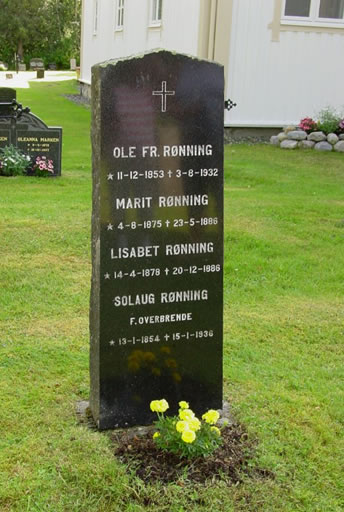
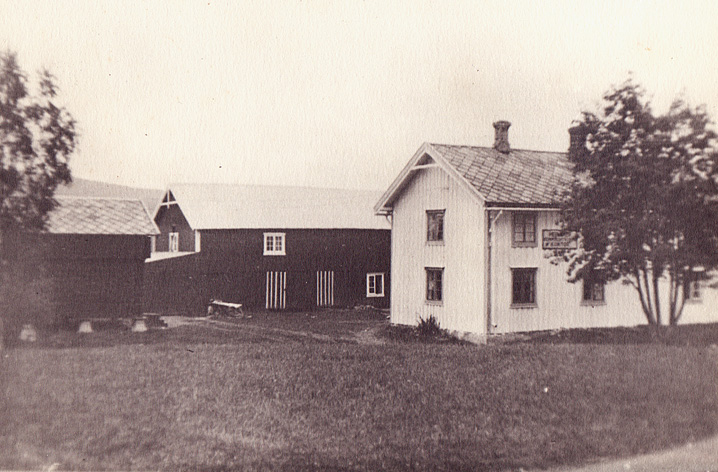
Rønningen gård
Ole og Solaug
